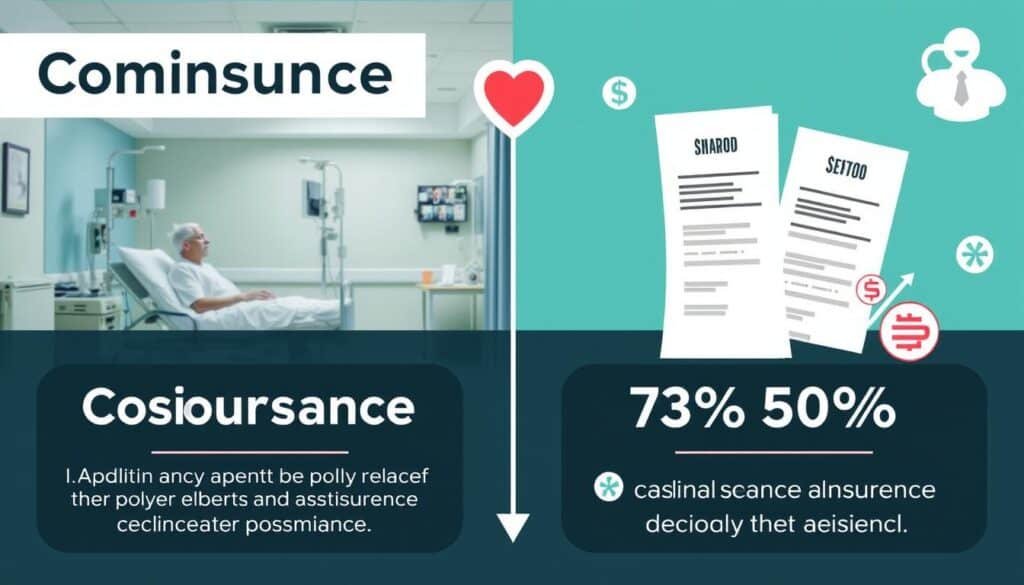Table of Contents
ToggleCoinsurance is a key term for those with health insurance. It’s the part of costs you pay after your deductible is met. Knowing how coinsurance works helps you manage healthcare costs better.
In this guide, we’ll cover coinsurance in detail. We’ll explain what it is, how it differs from deductibles, and its impact on your costs. We’ll also look at the differences between in-network and out-of-network coinsurance. Plus, we’ll share tips for dealing with coinsurance in Medicare plans. By the end, you’ll understand coinsurance well and make better healthcare choices.
Key Takeaways
- Coinsurance is a cost-sharing mechanism where the policyholder and the insurance company split the cost of covered healthcare services.
- Coinsurance kicks in after the policyholder has met their deductible, and it represents the percentage of costs the policyholder is responsible for.
- Understanding the difference between coinsurance and deductibles is crucial for managing healthcare expenses effectively.
- In-network and out-of-network coinsurance rates can vary significantly, so it’s important to be aware of these differences.
- Coinsurance is an essential aspect of Medicare plans, with specific guidelines for Part A and Part B coverage.
What is Coinsurance?
Coinsurance is a key part of healthcare insurance that everyone should know. It’s the percentage of healthcare costs that you pay after your deductible is met. For instance, if your plan has an 80/20 coinsurance, you pay 20% and the insurance covers 80%.
Also Read : Cyber Insurance: Protecting Your Business In The Digital Age
Coinsurance Explained
Coinsurance is not the same as a copayment, which is a fixed amount for a service. Coinsurance is based on a percentage, while a copayment is a set dollar amount. You pay your coinsurance until you hit your plan’s out-of-pocket maximum. Then, the insurance covers 100% of the costs.
Difference Between Coinsurance and Deductibles
The main difference between coinsurance and deductibles is how they work. A deductible is a fixed amount you pay before insurance kicks in. Coinsurance is a percentage you pay after the deductible is met. You must meet the deductible before coinsurance applies.
“Coinsurance is a crucial aspect of healthcare insurance that every policyholder should understand.”
How Does Coinsurance Work?

Coinsurance is a way for insurance and policyholders to share costs. The insurance company pays a set percentage of healthcare costs. The policyholder pays the rest. This helps split the cost of healthcare.
Calculating Coinsurance Payments
Coinsurance payments are based on a percentage of healthcare costs. For instance, if a service costs $1,000 and the plan is 80/20, the policyholder pays 20% or $200. The insurance company covers the other 80% or $800.
Also Read : The Role Of Insurance In Financial Security
Coinsurance Examples
- If a plan has a 20% coinsurance rate and a doctor’s visit costs $100, the policyholder pays $20. The insurance company pays $80.
- If a plan has a 30% coinsurance rate and a hospital stay costs $10,000, the policyholder pays $3,000. The insurance company pays $7,000.
- If a plan has a $25 copay and 20% coinsurance for drugs, the policyholder pays the $25 copay plus 20% of the rest.
Knowing how coinsurance works is key for policyholders. It helps them make smart healthcare choices and manage their costs.
Coinsurance and Out-of-Pocket Maximums

It’s important to know how coinsurance and out-of-pocket maximums work together. Coinsurance is the part of healthcare costs that you pay after your deductible. This amount goes up until you hit your plan’s out-of-pocket maximum.
The out-of-pocket maximum is the most you’ll pay for healthcare in a year. After you reach this limit, your insurance covers 100% of costs for the rest of the year. This total includes deductibles, copays, and coinsurance.
Keeping track of your out-of-pocket maximum is key to managing healthcare costs. Knowing how much you’ve paid helps you plan for future expenses. This way, you can budget better for your healthcare needs.
Also Read : Insurance Innovations: How Technology Is Transforming Coverage
| Metric | Value |
|---|---|
| Overall Deductible | $0 |
| Out-of-Pocket Limit | $2,600 for an individual and $5,200 for a family for covered services |
| Cost for a Primary Care Visit to Treat an Injury or Illness at Provider | $10/visit |
| Cost for a Specialist Visit at Provider | $30/visit |
| Cost for Preventive Care/Screening/Immunization at Provider | No charge |
| Cost for Diagnostic Tests (X-ray, Blood Work) at Provider | X-ray: $30/visit, Lab tests: $10/visit |
| Cost for Imaging (CT/PET Scans, MRIs) | $100/test |
Knowing about coinsurance and out-of-pocket maximums helps you manage your healthcare spending. It ensures you get the best value from your insurance.
Coinsurance for In-Network vs. Out-of-Network Care

Understanding the difference between in-network and out-of-network coinsurance is key. Coinsurance is the part of the cost you pay after your deductible. This amount changes based on whether the doctor is in-network or not.
In-Network Coinsurance
Getting in-network care means you pay less. Rates are often 80/20 or 90/10. This means you pay a smaller share, and your insurance pays more. Using in-network providers can lower your coinsurance costs.
Also Read : Freelancing Skills: How To Build A Competitive Portfolio
Out-of-Network Coinsurance
But, out-of-network care costs more. Rates are usually 50/50 or 60/40. So, you pay more, and your insurance pays less. This can increase your coinsurance costs.
Choosing in-network providers helps you save money. It makes paying for covered health care more affordable.
Medicare Coinsurance

Understanding coinsurance is key for Medicare beneficiaries to manage healthcare costs. Medicare Part A and Part B have different coinsurance rules. These rules can affect how much you pay out of pocket.
Medicare Part A Coinsurance
Medicare Part A covers inpatient hospital, skilled nursing facility, and some home health care. For Part A, you pay coinsurance for extended hospital stays and skilled nursing after a few days.
- The maximum monthly premium for Medicare Part A in 2024 is $505.
- There’s a Part A deductible of $1,600 in 2023 before coverage starts.
- After the deductible, Medicare Part A covers 100% for the first 60 days of a hospital stay.
- For days 61-90, the daily coinsurance rate is $400 in 2023.
- For each “lifetime reserve day” (up to 60 additional days), the coinsurance rate is $800 per day in 2023.
- For skilled nursing facility care, there’s a daily coinsurance rate of $200 for days 21-100 in 2023.
Medicare Part B Coinsurance
Medicare Part B covers outpatient services and supplies. For Part B, you usually pay 20% coinsurance after the yearly deductible. This means you pay 20% of the Medicare-approved amount for services.
Also Read : Freelancing Tips For Managing Client Relationships Successfully
| Medicare Part B Costs | 2024 |
|---|---|
| Standard Part B Premium | $174.70 |
| Part B Deductible | $240 per year |
| Part B Coinsurance | 20% of Medicare-approved amount |
Knowing about Medicare coinsurance is vital for beneficiaries to plan for healthcare costs. By understanding Part A and Part B coinsurance, you can better manage your healthcare expenses.
Tips for Managing Coinsurance Costs

Handling coinsurance can be tough, but there are ways to control your medical costs. Here are some tips to help:
- Look for a health plan with a lower coinsurance rate. It might cost a bit more each month. But, it can save you money when you use your insurance.
- Always choose in-network providers. Their coinsurance costs are much lower than out-of-network rates.
- Keep track of your deductible and out-of-pocket maximum. This helps you plan for future healthcare costs.
- Ask providers for cost estimates before getting care. This way, you can understand your coinsurance costs better and plan ahead.
- Use preventive services that are covered 100%. This can help avoid future medical bills and lower your out-of-pocket medical expenses.
- Put money into a health savings account (HSA) or flexible spending account (FSA). You can use pre-tax dollars for coinsurance costs and other medical expenses.
Using these strategies can help you manage your coinsurance costs better. This way, you can keep your healthcare expenses under control.
“Proactive management of your coinsurance costs can make a significant difference in your overall healthcare expenditures.”
Also Read : The Benefits Of Home Loan Insurance: Securing Your Mortgage
Conclusion
Coinsurance is a key part of health insurance that everyone needs to know. It helps people understand their healthcare costs better. Knowing how coinsurance works, including its differences from deductibles, helps make better choices.
It also matters whether care is in-network or out-of-network. This knowledge helps maximize the value of health insurance plans. It ensures that policyholders get the most from their coverage.
There are ways to lower coinsurance costs, like using preventative care and talking to providers. These steps help keep healthcare expenses down. As healthcare changes, understanding coinsurance is vital for managing costs and keeping good health insurance.
Being informed and managing coinsurance well helps people deal with healthcare systems better. It lets them get the care they need without financial stress. Knowing about coinsurance is key to controlling healthcare and using health insurance wisely.
FAQs
Q: What does coinsurance mean in health insurance?
A: Coinsurance is the percentage of the cost of a covered health care service that you pay after you’ve met your deductible. For example, if your plan pays 80% of the cost, you’ll pay your coinsurance, which would be 20% of the remaining amount.
Q: How do coinsurance and a copayment differ?
A: Coinsurance is typically a percentage of the cost of a service, while a copayment is a fixed amount you pay for a specific health care service. Both contribute to your out-of-pocket costs, but they function differently within your health insurance plan.
Q: When do I start to pay coinsurance?
A: You begin to pay coinsurance once you’ve met your deductible. This means that you need to pay a certain amount out-of-pocket for covered health care services before your insurance plan starts to share costs.
Q: How does coinsurance work with my insurance plan?
A: Coinsurance works by dividing the cost of covered health care services between you and your insurance provider. After you meet your deductible, you will be responsible for a coinsurance percentage of the costs, while the insurance plan will pay the remaining percentage.
Q: What is the maximum amount I might pay in coinsurance?
A: The maximum amount you could pay in coinsurance would be determined by your annual out-of-pocket maximum. Once you reach this limit, your insurance will pay 100% of your covered health care services for the rest of the year.
Q: Can coinsurance apply if I haven’t met my deductible?
A: No, coinsurance does not apply until you’ve met your deductible. Until then, you are responsible for paying the full cost of your health care services, aside from any copays that may apply.
Q: What happens if I have a plan with higher coinsurance?
A: If your plan has higher coinsurance, it means you will pay a larger percentage of the costs for covered health care services after meeting your deductible. This can lead to higher out-of-pocket costs, depending on your health care needs.
Q: How do copays and coinsurance work together in my health insurance plan?
A: Copays and coinsurance can both contribute to your out-of-pocket costs, but they are applied differently. You generally pay a copay for specific services, while coinsurance applies to the percentage of costs after your deductible is met. Both help manage your overall health care expenses.
Q: Are there any services where coinsurance doesn’t apply?
A: Yes, there are certain health care services where coinsurance doesn’t apply, typically preventive services that are covered at 100% without requiring you to meet your deductible. Always check your insurance policy for specific details.
Source Links
- https://www.uhc.com/communityplan/assets/plandocuments/2025/anoc/en/2025-CO-ANOC-H2001-053-000-EN.pdf
- https://www.peopleshealth.com/2025-medicare-advantage-plans/group-ogb/
- https://www.anthem.com/co/individual-and-family/health-insurance
- https://www.cms.gov/files/document/reduced-coinsurance-certain-part-b-rebatable-drugs-october-1-december-31-2024.pdf
- https://www.wellpoint.com/tn/medicare/medicare-advantage-plans
- https://www.bcbsfl.com/DocumentLibrary/sbc/2025/1442.pdf
- https://www.medicare.gov/drug-coverage-part-d/costs-for-medicare-drug-coverage/copaymentcoinsurance-in-drug-plans
- https://www.investopedia.com/average-2025-medicare-part-costs-bring-two-good-surprises-and-one-bad-one-8721622
- https://healthy.kaiserpermanente.org/content/dam/kporg/final/documents/health-plan-documents/summary-of-benefits/mas/dc/sg/2025/94506DC0350016-01-en-2025.pdf
- https://www.bluecrossmn.com/sites/default/files/DAM/2024-09/2025-medicare-decision-guide.pdf
- https://www.anthem.com/ct/individual-and-family/health-insurance
- https://www.discounttirefamily.com/benefits/full-time-employee-benefits/medical-benefits/
- https://www.uhc.com/communityplan/assets/plandocuments/2025/sob/en/2025-PA-SOB-H1889-007-000-EN.pdf
- https://www.cigna.com/medicare/member-resources/pharmacy-networks
- https://www.healthpartners.com/insurance/medicare/part-d-prescription-drug-coverage/formulary/
- https://www.dailyitem.com/wire/medicare-changes-for-2025-what-you-need-to-know/article_e5fe5641-06a8-5240-ab71-6fce1f48ca3c.html
- https://www.nerdwallet.com/article/insurance/medicare/medicare-prescription-payment-plan
- https://www.priorityhealth.com/individual-family-health-insurance/learning-center/oep-checklist
- https://www.pymnts.com/study_posts/self-care-deficit-impacts-womens-health-and-healthcare-spending/
- https://www.ermersuter.com/blog/
- https://immigrantinvest.com/blog/best-healthcare-countries/




